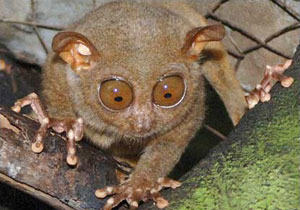Philippine Tarsier
The Philippine Tarsier is an animal that not very many outside of the Philippines are familiar with. This creature is thought to be more than 45 million years old and was named for the tarsus bone, located in the ankle. The Philippine Tarsier is an endangered species and there is a foundation that has just one mission, and that is to protect this creature any way they can.
The Habitat of the Philippine Tarsier

A Philippine tarsier in Bohol
The Philippine Tarsier generally calls about one to two hectares of land its home. Some studies have shown that the male usually lives on 6.45 hectares and the female on 2.45 hectares for a total population of 14 male and 41 females per 100 hectares. The animals are of the solitary variety, but they are known to come in contact with one another briefly during the night when they are actively hunting. These primates are found in Bahol, Samar, Leyte, Mindanao, as well as on the islands of Marippi, Siargoa, Basilan, and Dinagat.
The Diet of the Philippine Tarsier
The Philippine Tarsier is a carnivore and eats mostly live insects but will also feed on spiders, crustaceans, lizards, and birds when live insects are not readily available. It has been observed that the Tarsier favors crickets and grasshoppers when they have a choice. When the Philippine Tarsier has captured its prey it will bring the food to its mouth with both of its small hands. It has been said that the Philippine Tarsier is able to easily catch its prey because it is small, agile, able to maneuver amazingly through the trees, and when it communicates it sounds very much like a locust so other insects do not know that they are being hunted until it is too late.

A very innocent looking Philippine Tarsier
Reproduction of the Philippine Tarsier
While these are shy, solitary creatures they do come together for reproductive purposes. The mating season begins in April and lasts usually until the end of May. The female is fertile for 25-28 days and after intercourse the female will become pregnant and will carry the fetus for about six months. This species gives birth to just one live young per pregnancy and the infants are born with their eyes open and a full body of hair. The mother cares for the young and carries it in her mouth. After just one month outside of the womb the young will start leaping from one tree to the next. The species has a poor track record for reproducing in captivity.



What a cute animal?
These are my favorite animals in the world and it saddens me that the tarsiers are becoming endangered coming to a populartion of almost 1,000-5,000 (I should think, correct me if it’s wrong.)
These animals are nocturnal meaning they should sleep during the day but that can become harder and harder because of their captivity and the tourists’ coming and making so much noise that can awaken them easily.
Something else I noticed you didn’t seem to include were their eyes. Their eyes cannot move so they depend on their neck bones that can turn up to 180 degrees.
Their names come from their strong and long tarsus ankle bone that’ll allow them to hop from tree to tree with no trouble at all. Their tails are longer than their bodies (maybe even double the length) and is naked except a small tuft in the end.
these website I answer my ASSIGNMENT this web i use to answer my ASSIGNMENT!!!!
THANKS FOR WHO MADE THIS SITES
awww this is so cute!
its eyes make me laugh
everyone this animal is awesome i am going to buy one when i get older
dont buy one! thats what’s making them endangered! people are catching them and stuffing them to sell them to tourists. please, if u want to keep seeing them around, do not buy one for a pet or stuffed, it’s killing them
don’t buy one! tarsiers are know to either starve themselves or break their own necks (on purpose) when takenn out of their natural environment.
I am using this animal for my resarch paper. I love it. It’s so cute and I am Filipino, so This is an awesome animal!!!
what ever me to
what ever me to
me too :)
LOL!! They are cute in a ugly way!
Very educational site.
I know i am doing a report on this x
screw you im getting one!!!!!!!!!!!!